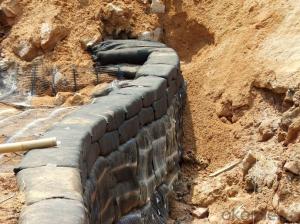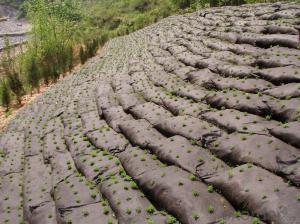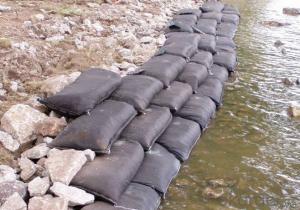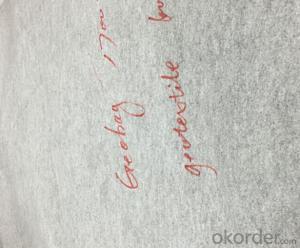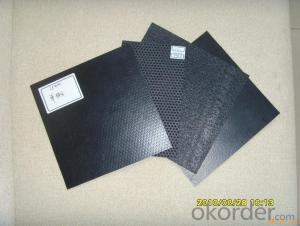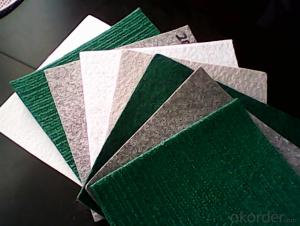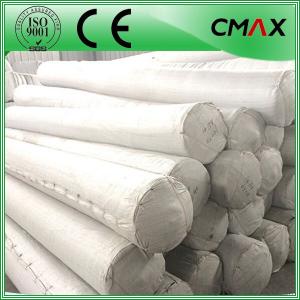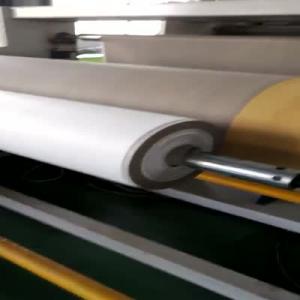PP Geo Textile Bag for Slop Engineering
- Loading Port:
- China main port
- Payment Terms:
- TT OR LC
- Min Order Qty:
- 30000 m²
- Supply Capability:
- 300000 m²/month
OKorder Service Pledge
OKorder Financial Service
You Might Also Like
1,Brief Introduction of PP Geo Textile Bag for Slop Engineering
Geotextile bags that component is PP or PET needle punched non woven fabric
It is a greener environmental protection solutions used for erosion control ,embankment/slope protection and shoreline stabilization, stormwater management, and the creation of rain gardens and other functional green spaces.
color:white,black,deep green,grey,etc
Size:60cm*45cm,85cm*45cm,95cm*35cm,103cm*70cm,110cm*50cm,etc
2,Feature of PP Geo Textile Bag for Slop Engineering
Strong corrosion resistance ,UV resistance, anti-aging, non-toxic, non-combustion,good stability,split not extend etc. features.Anti-rot,anti-degradation,pests erosion resistance.
3,Package of PP Geo Textile Bag for Slop Engineering
Stardard export package or as per your request
4,Application of PP Geo Textile Bag for Slop Engineering
1).Ecohydraulic Engineering:
Natural environment for both sides of the ecological river, soil and water conservation,reservoir fluctuation zone regreening, wetland project, coastal engineering etc.
2.)Highway Engineering:
Roadbed side slope,retaining wall project, massif excavate side slope,bridgepier slope protection,culvert exits and entrances "Eight word" wall,sound protective screen, ecological isolation strip,swelled ground side slope,freeze thawing district side slope etc.
3).Railway Engineering:
Roadbed side slope,retaining wall project, massif excavate side slope,bridgepier slope protection,culvert exits and entrances "Eight word" wall,ecological beauty spot ecological district side slope,ecological fragile district ecological side slope etc.
4).Municipal garden engineering:
Massif regreening,massif excavate side slope,urban center ecological river bank,pack lakeshore,puente hills landfill,mine regreening,golf course,gardening landscape wall,
saline-alkali soil side slope etc.
5).Real estate landscape engineering:
Artificial landscape riverway,uptown side slope,gardening landscape wall,hydrophile retaining wall,roof greening ,etc
6).Others:
Slope body collapsed emergency manage,desert greening,natural reserves,the coast protection embankment,ammunition storage place,flood protection wall,ecological vertical wall etc.
5.FAQ
We have organized several common questions for our clients,may help you sincerely:
1>How about your company?
A manufacturer & supplier focuses on the production of geo textile and geo bag etc. We have exported this product to Amereica, Europe and South East Asia. Customized product is also available based on your detailed requirements.
2> What's the MOQ ?
We kindly recommend 1x40'HQ as the price would be economical based on large loading quantity.
3>How long can we receive the product after purchase?
It takes about 1 to 2 weeks to finish the production based on the specific production schedual. Then it will depend on the shipping time from loading port to the destination port.

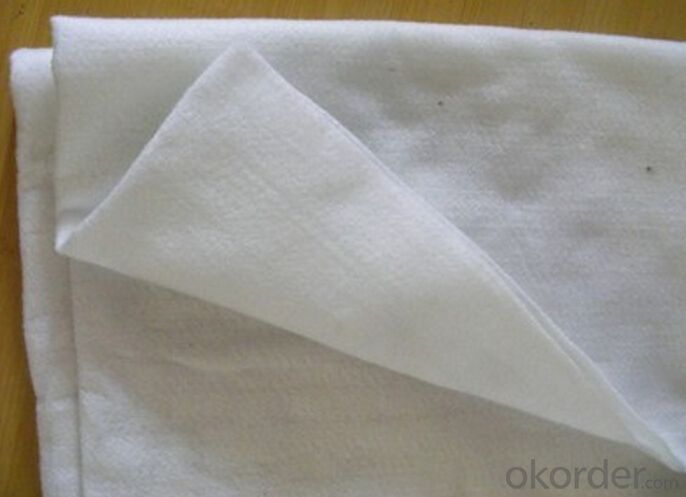

- Q:Geotextile detection sampling, how many meters
- General a square meter can be, I professional production
- Q:SNG400-3.5 geotextile is what model
- SNG400-3.5 refers to the national standard polyester staple acupuncture non-woven geotextile 400g / ㎡, width 3.5m. The index code for staple acupuncture nonwoven geotextiles is generally SNG / (1) (2) / (3) - (4) / (5). (1) that the use of raw materials fiber code: PET-polyester, PP-polypropylene, PA-nylon, PV-vinylon, PE-Ethylene (conventional polyester are generally vacant omitted code) (2) that polyester staple fiber non-woven Geotextile per unit area weight. (3) that the composite products in the polyester staple fiber non-woven geotextile weight per unit area, non-composite product vacancies. (4) width, expressed in meters (5) production department number: can express the product more specific characteristics, functions, varieties, sequences, etc., the general vacancy. For example, a 3.5m wide 400g / ㎡ polyester staple fiber nonwoven geotextile representation can be SNG / PET400-3.5, can also be expressed as SNG400-3.5
- Q:Waterproof geotextile how much money per square meter
- This material has a lot of different quality, there are many different requirements, the price from dozens of pieces to more than 100 pieces between.
- Q:Are geotextiles suitable for use in underground drainage systems?
- Yes, geotextiles are suitable for use in underground drainage systems. Geotextiles are designed to provide filtration, separation, and reinforcement in various civil engineering applications, including drainage systems. They can help prevent soil and fine particles from clogging the drainage pipes, while allowing water to pass through freely. Geotextiles also enhance the overall performance and longevity of the drainage system by reducing soil movement and erosion.
- Q:What are the key properties of geotextiles?
- Geotextiles are permeable fabrics that are used in various civil engineering applications. The key properties of geotextiles include their ability to provide filtration, separation, reinforcement, and drainage. They are durable, resistant to biological and chemical degradation, and have high tensile strength. Geotextiles also offer good water permeability, allowing for effective water flow while preventing soil erosion.
- Q:What are the specifications for geotextiles in gas venting projects?
- The specifications for geotextiles in gas venting projects typically include factors such as the required permeability, strength, and durability. The geotextile should have a high porosity to allow efficient gas flow while preventing the passage of fine particles. It should also possess sufficient tensile strength and puncture resistance to withstand installation and long-term exposure. Additionally, UV resistance and chemical compatibility with the surrounding environment are crucial considerations to ensure the geotextile's longevity and performance in gas venting projects.
- Q:What are the specifications for geotextiles in drainage projects?
- The specifications for geotextiles in drainage projects typically include factors such as the material type, weight, permeability, and strength. The geotextiles should be made of durable and non-biodegradable materials such as polypropylene or polyester. The weight of the geotextiles is generally specified in terms of grams per square meter (gsm), with heavier weights often preferred for better performance. Permeability is an important factor, and geotextiles with high permeability allow for efficient water flow while preventing soil erosion. Additionally, the geotextiles should possess adequate strength to withstand installation stresses and ongoing loadings. Overall, the specifications ensure that the geotextiles effectively separate, filter, and reinforce the soil in drainage projects.
- Q:What are the cost implications of using geotextiles in construction projects?
- The cost implications of using geotextiles in construction projects can vary depending on factors such as the type and quality of the geotextile, the size and complexity of the project, and the specific requirements of the site. Geotextiles can contribute to cost savings by reducing the need for traditional construction materials, such as aggregate or soil, and by improving the longevity and performance of the project. Additionally, geotextiles can help minimize maintenance and repair costs by providing erosion control, drainage, and stabilization. However, the initial investment in geotextiles and their installation may increase upfront costs compared to traditional construction methods. Overall, a thorough cost-benefit analysis should be conducted to determine if using geotextiles is financially advantageous for a specific construction project.
- Q:How do geotextiles contribute to soil filtration?
- Geotextiles contribute to soil filtration by acting as a barrier that allows water to pass through while retaining soil particles. They enhance the filtration process by preventing the migration of fine particles and protecting the underlying soil from erosion.
- Q:Can geotextiles be used in geosynthetic clay liner applications for containment systems?
- Yes, geotextiles can be used in geosynthetic clay liner applications for containment systems. Geotextiles are often used as a component in geosynthetic clay liners to enhance their performance by providing additional reinforcement, filtration, and separation functions. They help to improve the overall stability, filtration, and hydraulic properties of the liner system, making it an effective solution for containment applications.
1. Manufacturer Overview |
|
|---|---|
| Location | |
| Year Established | |
| Annual Output Value | |
| Main Markets | |
| Company Certifications | |
2. Manufacturer Certificates |
|
|---|---|
| a) Certification Name | |
| Range | |
| Reference | |
| Validity Period | |
3. Manufacturer Capability |
|
|---|---|
| a)Trade Capacity | |
| Nearest Port | |
| Export Percentage | |
| No.of Employees in Trade Department | |
| Language Spoken: | |
| b)Factory Information | |
| Factory Size: | |
| No. of Production Lines | |
| Contract Manufacturing | |
| Product Price Range | |
Send your message to us
PP Geo Textile Bag for Slop Engineering
- Loading Port:
- China main port
- Payment Terms:
- TT OR LC
- Min Order Qty:
- 30000 m²
- Supply Capability:
- 300000 m²/month
OKorder Service Pledge
OKorder Financial Service
Similar products
New products
Hot products
Hot Searches
Related keywords

